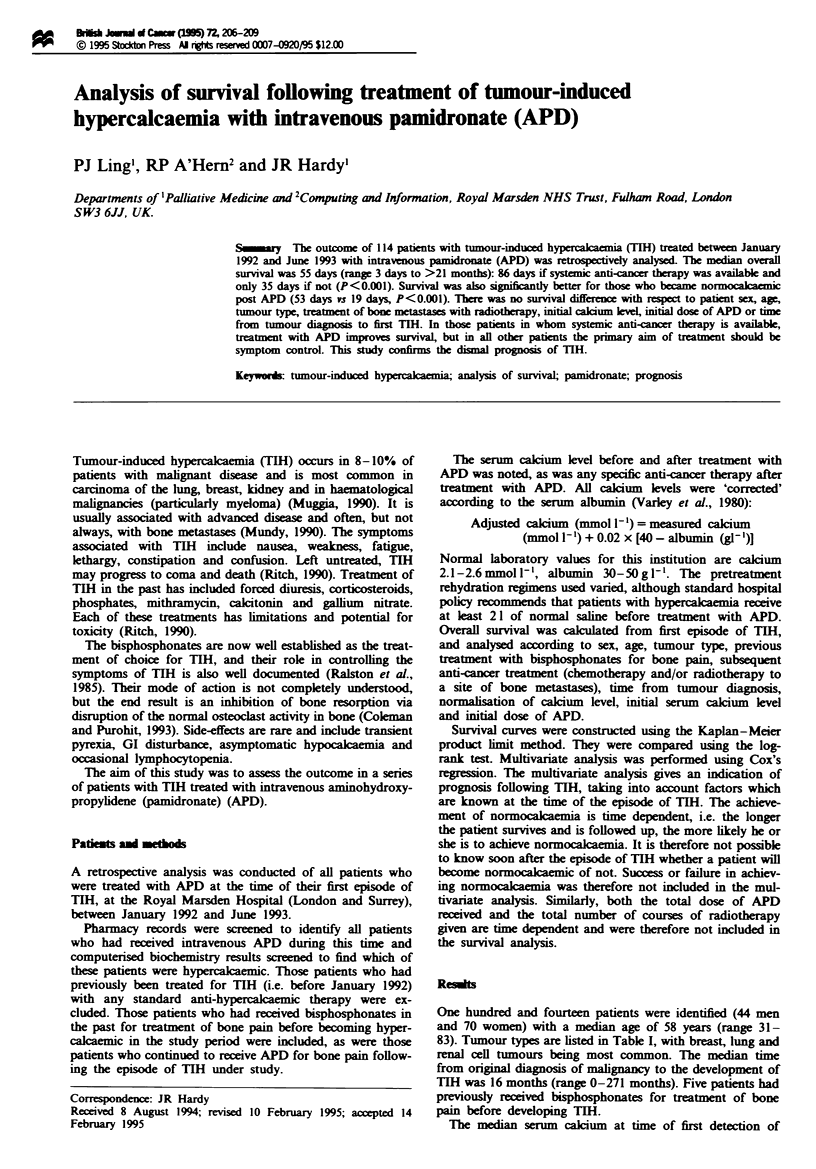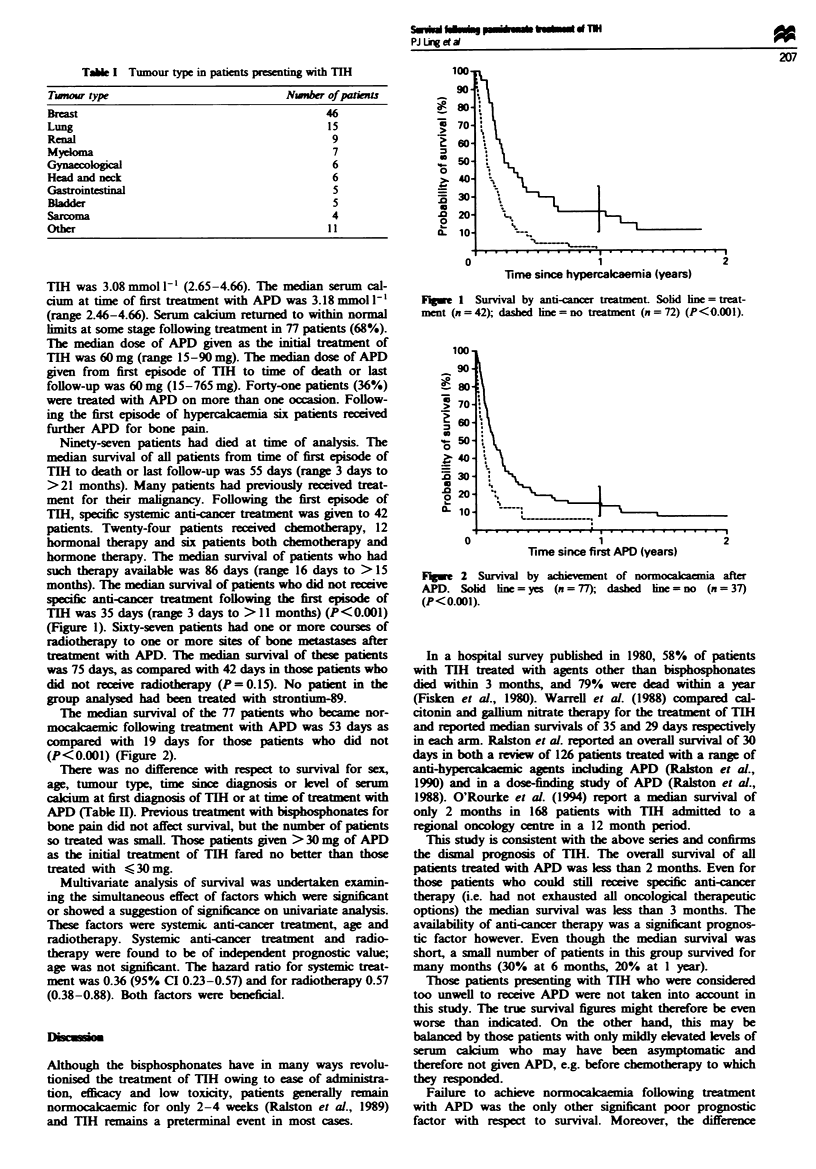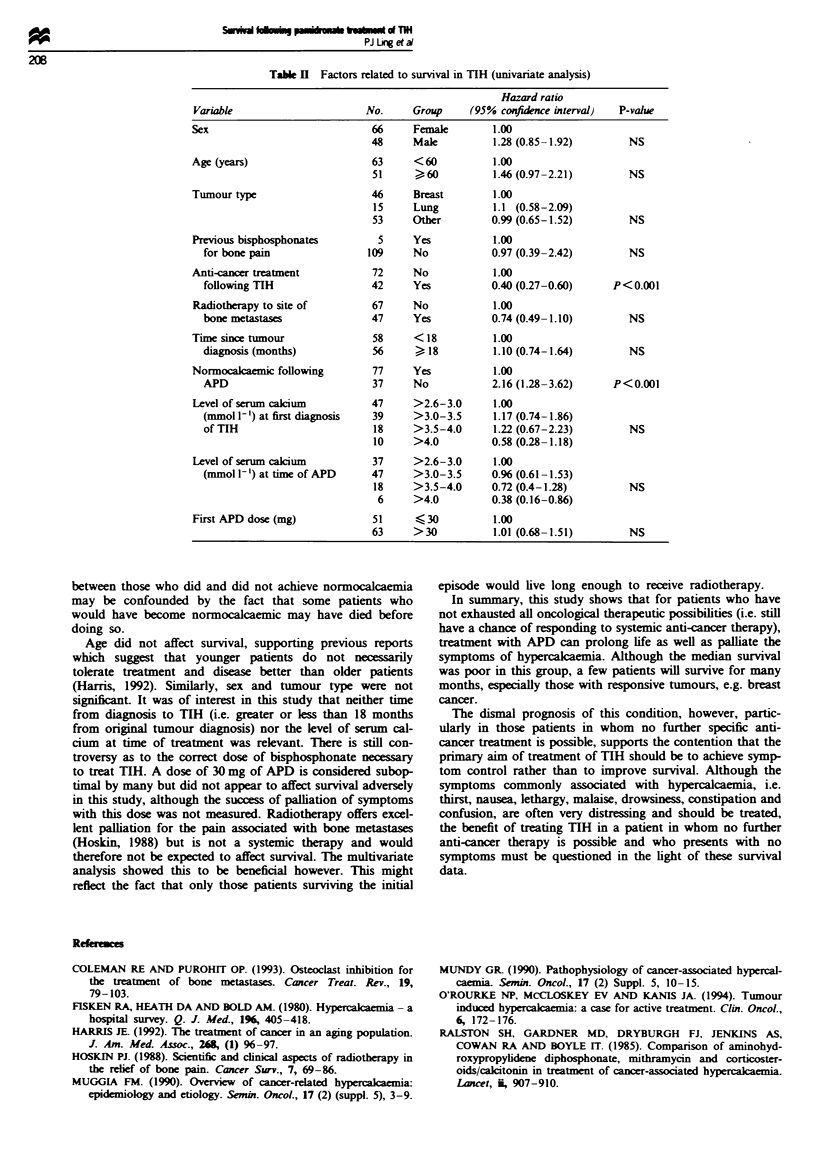Abstract
The outcome of 114 patients with tumour-induced hypercalcaemia (TIH) treated between January 1992 and June 1993 with intravenous pamidronate (APD) was retrospectively analysed. The median overall survival was 55 days (range 3 days to > 21 months): 86 days if systemic anti-cancer therapy was available and only 35 days if not (P < 0.001). Survival was also significantly better for those who became normocalcaemic post APD (53 days vs 19 days, P < 0.001). There was no survival difference with respect to patient sex, age, tumour type, treatment of bone metastases with radiotherapy, initial calcium level, initial dose of APD or time from tumour diagnosis to first TIH. In those patients in whom systemic anti-cancer therapy is available, treatment with APD improves survival, but in all other patients the primary aim of treatment should be symptom control. This study confirms the dismal prognosis of TIH.
Full text
PDF



Selected References
These references are in PubMed. This may not be the complete list of references from this article.
- Coleman R. E., Purohit O. P. Osteoclast inhibition for the treatment of bone metastases. Cancer Treat Rev. 1993 Jan;19(1):79–103. doi: 10.1016/0305-7372(93)90028-p. [DOI] [PubMed] [Google Scholar]
- Fisken R. A., Heath D. A., Bold A. M. Hypercalcaemia--a hospital survey. Q J Med. 1980 Autumn;49(196):405–418. [PubMed] [Google Scholar]
- Harris J. E. The treatment of cancer in an aging population. JAMA. 1992 Jul 1;268(1):96–97. [PubMed] [Google Scholar]
- Hoskin P. J. Scientific and clinical aspects of radiotherapy in the relief of bone pain. Cancer Surv. 1988;7(1):69–86. [PubMed] [Google Scholar]
- Mundy G. R. Pathophysiology of cancer-associated hypercalcemia. Semin Oncol. 1990 Apr;17(2 Suppl 5):10–15. [PubMed] [Google Scholar]
- O'Rourke N. P., McCloskey E. V., Kanis J. A. Tumour induced hypercalcaemia: a case for active treatment. Clin Oncol (R Coll Radiol) 1994;6(3):172–176. doi: 10.1016/s0936-6555(94)80057-x. [DOI] [PubMed] [Google Scholar]
- Ralston S. H., Alzaid A. A., Gallacher S. J., Gardner M. D., Cowan R. A., Boyle I. T. Clinical experience with aminohydroxypropylidene bisphosphonate (APD) in the management of cancer-associated hypercalcaemia. Q J Med. 1988 Oct;68(258):825–834. [PubMed] [Google Scholar]
- Ralston S. H., Gallacher S. J., Patel U., Campbell J., Boyle I. T. Cancer-associated hypercalcemia: morbidity and mortality. Clinical experience in 126 treated patients. Ann Intern Med. 1990 Apr 1;112(7):499–504. doi: 10.7326/0003-4819-112-7-499. [DOI] [PubMed] [Google Scholar]
- Ralston S. H., Gallacher S. J., Patel U., Dryburgh F. J., Fraser W. D., Cowan R. A., Boyle I. T. Comparison of three intravenous bisphosphonates in cancer-associated hypercalcaemia. Lancet. 1989 Nov 18;2(8673):1180–1182. doi: 10.1016/s0140-6736(89)91791-1. [DOI] [PubMed] [Google Scholar]
- Ralston S. H., Gardner M. D., Dryburgh F. J., Jenkins A. S., Cowan R. A., Boyle I. T. Comparison of aminohydroxypropylidene diphosphonate, mithramycin, and corticosteroids/calcitonin in treatment of cancer-associated hypercalcaemia. Lancet. 1985 Oct 26;2(8461):907–910. doi: 10.1016/s0140-6736(85)90848-7. [DOI] [PubMed] [Google Scholar]
- Warrell R. P., Jr, Israel R., Frisone M., Snyder T., Gaynor J. J., Bockman R. S. Gallium nitrate for acute treatment of cancer-related hypercalcemia. A randomized, double-blind comparison to calcitonin. Ann Intern Med. 1988 May;108(5):669–674. doi: 10.7326/0003-4819-108-5-669. [DOI] [PubMed] [Google Scholar]


